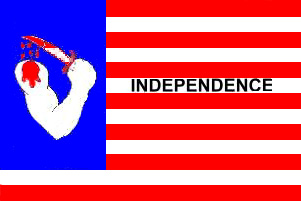
Brown's Flag of Independence.

Brown's Flag of Independence.
There it may have been flown in front of the American Hotel on 8 Jan 1836 along with the Troutman flag of the Georgia Battalion. Author John Henry Brown (History of Texas) stated "Over the cabin in which the convention met and declared for independence, floated a flag with the design of a sinewy hand grasping a red sword, and underneath this was a lone star flag." Mamie Wynne Cox in Romantic Flags of Texas says "As Captain Brown's Flag was the only banner carrying a design of a bloody sword, this could have been none other than his." Cox describes the Brown flag as a large deep blue field in the upper left corner, in which is a white arm grasping a sword fromt he point of which is dripping blood. The flag has thirteen stripes, seven red and six white with the word INDEPENDENCE in the third white stripe from the top. Author Brown's description does not clearly describe either of the two "bloody arm" flags or the lone star flag. He appears to be referring to two flags on the same pole, although it could even have been a composite single banner.(Image adapted from Gilbert, Flags of Texas)
Courtesy: Sons of Dewitt Colony Texas